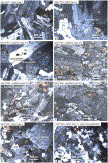R. Somoza, A.J. Tomlinson, C.B. Zaffarana, S.E. Singer, C.G. Puigdomenech Negre, M.I.B. Raposo, J.H. Dilles
2 015
Tectonophysics, Volume 654, 18 July 2015, Pages 113–130
A paleomagnetic and AMS study on Eocene plutonic complexes in the Calama area, northern Chile, reveals high-temperature, high-coercivity magnetizations of dominantly thermoremanent origin and magnetic fabrics controlled by magnetite. The paleomagnetic results indicate that ~ 43 Ma plutons underwent clockwise tectonic rotation, whereas adjacent ~ 39 Ma plutons did not undergo discernible rotation. This points to a middle Eocene age for the younger tectonic rotations associated with the Central Andean Rotation Pattern in the Chuquicamata–Calama area.
The petrofabric in these rocks formed under conditions ranging from purely magmatic (i.e. before full crystallization) to low-temperature solid-state deformation. AMS and paleomagnetism suggest that the plutonic bodies were formed by progressive amalgamation of subvertical magma sheets spanning multiple magnetic polarity chrons. The parallelism between magmatic and tectonic foliations suggests that regional tectonic stress controlled ascent, emplacement and rock deformation during cooling. In this context, we suggest that magma ascent and emplacement in the upper crust likely exploited Mesozoic structures which were locally reactivated in the Eocene.
The petrofabric in these rocks formed under conditions ranging from purely magmatic (i.e. before full crystallization) to low-temperature solid-state deformation. AMS and paleomagnetism suggest that the plutonic bodies were formed by progressive amalgamation of subvertical magma sheets spanning multiple magnetic polarity chrons. The parallelism between magmatic and tectonic foliations suggests that regional tectonic stress controlled ascent, emplacement and rock deformation during cooling. In this context, we suggest that magma ascent and emplacement in the upper crust likely exploited Mesozoic structures which were locally reactivated in the Eocene.

